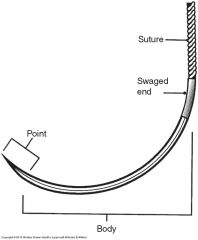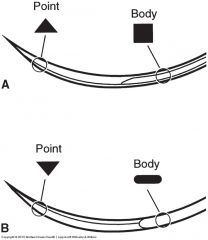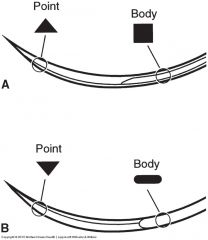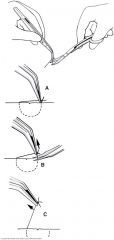![]()
![]()
![]()
Use LEFT and RIGHT arrow keys to navigate between flashcards;
Use UP and DOWN arrow keys to flip the card;
H to show hint;
A reads text to speech;
46 Cards in this Set
- Front
- Back
|
the shaping of the peripheries of a dressing by manual manipulation of the tissue adjacent to the borders to duplicate the contour and size of the vestibule |
border mold |
|
|
mode of self-cure or setting of a dressing in which the ingredients unite in a chemical process that starts as son as the blending is complete; the setting time is influenced by warm temperature and the addition of an accelerator |
chemical cure |
|
|
to approximate, as the edges of a wound; bring edge to edge with no overlap |
coapt |
|
|
constituent of clove oil; used in early periodontal dressings with zinc oxide for its alleged antiseptic and anodyne properties; more recently found to be toxic, to elicit allergic reactions, and to hinder, more than promote, healing |
eugenol |
|
|
the termination of bleeding by mechanical or chemical means or by the complex coagulation process of the body that consists of vasoconstriction, platelet aggregation, and thrombin and fibrin synthesis |
hemostasis |
|
|
a process by which water slowly penetrates the suture filaments, causing breakdown of the suture's polymer chain; yields a lesser degree of tissue reaction |
hydrolysis |
|
|
application of a wire or thread (suture) to hold or constrict tissue |
ligation |
|
|
presence of potentially pathogenic microorganisms; opposite of asepisis: the absence of infectious material |
septic |
|
|
a stitch or series of stitches made to secure apposition of the edges of a surgical or traumatic wound |
suture |
|
|
a suture that holds the margins of an incision close together |
suture apposition |
|
|
the fusion of a suture material to the needle, which allows for a smooth eyeless attachment; the suture will then pass through the tissue as smoothly as possible |

swage |
|
|
amount of strength the suture material will retain throughout the healing period; as the would gains strength, the suture loses strength |
tensile strength |
|
|
light activation using a photocure system; shorter curing time than self-cure; does not start setting until the light is activated, thereby allowing longer working time for adapting the dressing material |
visible light-cure |
|
|
A ______ is a strand of material used to ligate blood vessels and approximate tissue. |
suture |
|
|
Functions of Sutures |
|
|
|
Characteristics of Suture Materials |
Sterile Handle Comfortably and Easily Pass through Tissue with Minimal Trauma Cause Little or No Tissue Reaction Possess a High Tensile Strength |
|
|
single strand of material |
monofilament |
|
|
several strands twisted or braided together |
multifilament |
|
|
capable of causing adverse tissue reaction |
natural |
|
|
developed to reduce tissue reactions and unpredictable rates of absorption commonly found in natural sutures |
synthetic |
|
|
approximate tissue until wound heals sufficiently to endure normal sress |
absorbable sutures
*implant flap closure* |
|
|
digested by body enzymes
*surgical gut & chromic gut* |
natural absorbable sutures
*used for extraction socket & bone grafting* |
|
|
broken down by hydrolysis |
synthetic absorbable sutures |
|
|
not digested by body enzymes or hydrolyzation; must be removed within specific time period |
nonabsorbable sutures |
|
|
silk |
natural nonabsorbable |
|
|
nylon, polyester, polypropylen |
synthetic nonabsorbable |
|
|
The diameter of sutures ranges from ____ to _______. |
1-0 to 11-0 |
|
|
More zeros the ____ the diameter and fewer zeros equals ______ diameter. |
smaller
larger |
|
|
What shape can a needle be? |

Straight Half-Curved Curved |
|
|
Most needles are _______ _______ formulated and sterilized for surgical use. |
stainless steel |
|
|
it has two opposing cutting edges, with a third located on outer convex curve of needle |

reverse cut (B) |
|
|
it consists of two opposing cutting edges and a third within the concave curvature of the needle |

conventional cut (A) |
|
|
______ and ______ knots are the most frequently used in dentistry. |
surgeons
square |
|
|
A knot should be tied as ______ as possible. |
small |
|
|
Knots should be tied on the _____ aspect for easier access for removal and ___ to ____ mm of a tail should be left to assist in locating at the time of removal. |
facial
2 to 3 |
|
|
stitch is brought over a loop of the preceding one, thus forming a series of loops on one side of the incision and a series of stitches over the incision |

blanket stitch (A) |
|

What stitch is shown in B? |
interrupted |
|
|
a series of stitches tied at one or both ends |
continuous uninterrupted |
|
|
a term applied to a suture that encircles a tooth for suspension and retention of a flap |
circumferential |
|
|
where the flaps are on both the lingual and facial sides, interdental ligation joins the two by passing the suture through each interdental area |

interdental (C) |
|
|
when a flap is only on one side, facial or lingual, the sutures are passed through the interdental papilla, around the tooth, and into the adjacent papilla |

sling or suspension (D) |
|
|
Sutures are schedules for removal ___ days after the surgery or no longer than ____ days to prevent tissue infection and promote healing. |
7
14 |
|
|
Suture removal can cause ____; high-risk patients may need antibiotic premedication for suture removal. |
bacteremia |
|

Steps for Suture Removal |
A: Suture grasped by pliers near the entrance into tissue.
B: Suture pulled gently up while scissor is inserted close to the tissue. Suture is cut in the part previously buried in the tissue
C: Suture is held up for vertical removal.
D: Suture is pulled gently to bring it out on the side opposite from where it was cut. |
|
|
Dressings may be placed over the surgical wound following surgery. Dressings are not used to _____ the wound but to ______ the tissue. |
cure
protect |
|
|
What are the four types of dressings used? |
Zinc Oxide with Eugenol Dressing (Bad Taste/Allergic Reactions) Chemical-Cured Dressing (Easy to work with) Visible Light-Cured Dressing (Looks like Gingiva) Collagen Dressing (Wound Healing)
|

